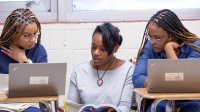A Framework For Supporting New Teachers
A school-based program can provide crucial support for novices throughout their first two years in their new profession.
Your content has been saved!
Go to My Saved Content.Despite the fact that many new teachers enter the field hoping to make a positive impact on the lives of students, data reveals that many don’t make it to their second year of teaching. Approximately 11 percent of new teachers leave the profession at the end of their first year, while almost half of new teachers leave the profession within their first five years.
So, what happens between the completion of student teaching and the end of the first year as an official classroom teacher? Student behavior, lack of teacher support and collaboration, burnout, insufficient access to resources—these are just a few issues that impact new teacher attrition.
As an assistant principal, I noticed that several first-year teachers were joining our staff. I wanted to do my part to ensure that our new staff members had everything they’d need to be successful, so we started a school-based new teachers program for first- and second-year teachers.
Through this two-year mentoring program, new teachers were provided with intensive support to assist them in making a smooth transition from pre-service activities to their new profession, as well as opportunities for continuous instructional improvement in a collaborative environment.
Program Benefits
This program was intended to benefit new teachers, of course, but also had a positive impact on veteran teachers and administration.
New teachers
- learned about school policies and culture,
- received emotional support to ease their anxieties, and
- engaged in professional growth activities that enhanced their knowledge of effective teaching strategies and techniques.
This all resulted in our new teachers choosing to remain in the profession longer, while also maintaining their initial enthusiasm.
Veteran teachers were selected to become mentor teachers. The program
- required them to become more reflective practitioners as they needed to articulate what they were doing, and why;
- provided them with an opportunity to transfer their knowledge and skills in effective classroom practice; and
- nurtured the exchange of new ideas from a fresh perspective, which reignited veteran teachers’ enthusiasm and motivation for teaching.
Through the use of mentor teachers, we were able to identify and develop a cadre of teacher leaders who supported instruction and classroom management. This program bolstered the efforts of our administrative team to improve teacher quality and effectiveness, while also helping us to build a culture of collaboration among our staff that encouraged collegial problem-solving.
Program Structure and Timelines
Over the summer, the administrative team selected a mentor for each new teacher. Mentor teachers were responsible for serving as role models in professional and classroom practice, fostering a trusting relationship with their mentee, as well as meeting with the new teacher weekly for the first 10 weeks of the school year. Meetings occurred two times a month thereafter. Prior to meeting their mentees, mentor teachers participated in mentor training and received continuous feedback at least three times during the school year to help them improve as mentors.
Prior to the start of school, new teachers reported early to attend an orientation tailored to their needs. During orientation, topics like time management and balance, effective communication, managing your expectations as a beginning teacher, getting to know your students, classroom management, and record keeping were covered. On the last day of orientation, all new teachers met their mentors and were allotted time to prepare and present a lesson plan.
After the orientation, the new teachers were to observe at least one teacher and meet as a group with the program administrators once a month. Each session was governed by one of the program focus areas:
- Classroom Management and Organization
- Instruction
- Students
- Parents
- School Context
- Professionalism
Sessions began with a check-in prompt and feedback about lessons learned from classroom observation. At the end of the session, new teachers were given time to share openly. Because the program was designed to provide support through mutual trust and respect, program administrators worked diligently to maintain a safe and confidential environment for the new teachers.
Reflections and Celebration
All program participants were required to maintain a reflection journal—to encourage consistent reflection on classroom practices—and a portfolio of best practices—a nonevaluative record of successes that captured the new teachers’ journeys in developing effective teaching practices.
The portfolio contained elements such as a unit plan, a videotape of a lesson, a parent contact log, a list of helpful websites, and notes from students or parents that motivated the teacher—all of which was presented during the final session. Additionally, the final session was used to celebrate the second-year teachers.
After the teachers presented their portfolios, they were surprised with words of gratitude from students or parents who were invited as their special guests. Administration presented them with awards and gifts, and they were formally welcomed into the profession by the veteran teachers.
Overall, the program served as a significant morale booster for the entire school, keeping all staff members mindful of why they had joined the profession: to make a difference in the lives of students.
